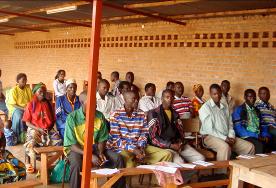

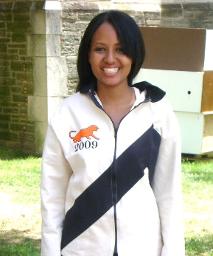
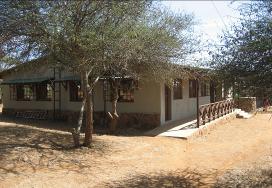

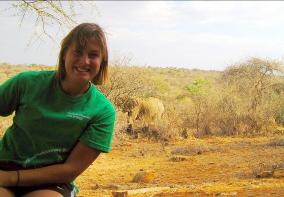
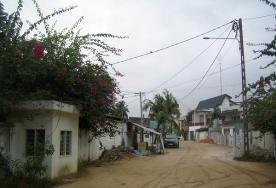
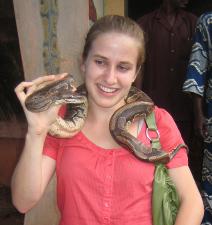
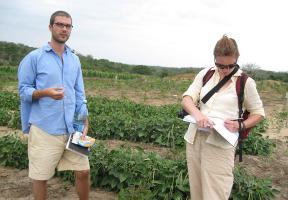
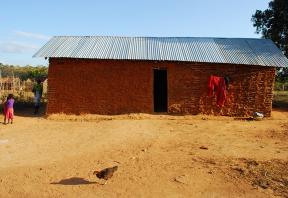



|
Fellows’ Flyer |
|
October/November 2009 |
|
News and views for and by Princeton in Africa Fellows |
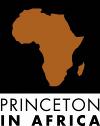

|
In this Issue: |
|
Highlights from 2009-2010 Fellows Clare Hunt in Kenya, Adrienne Clermont in Benin, Luwam Berhane in Burundi, and Allison Williams in Kenya |

|
What better way to connect with the people we are trying to serve, than to stay with them for a couple of days on a “homestay?” Komaza, a nonprofit start-up “social business” that aims to link rural farmers’ cash crops with formal markets and to boost incomes of those living in absolute poverty in Kenya, requires homestays—once a quarter—for each and every Associate like me. The experience will be forever etched in my memory.
I stayed with a rural farming family of six that ekes out a living on ASAL (“arid and semi-arid land”). I was the first Mzungu to stay in their remote community. Ever. They invited me into their mud hut home (mud floors and walls, and a corrugated tin roof—a luxury). They had no running water or electricity, though they did have a paraffin lamp— another luxury. I went about their daily tasks: carrying 20L gerry cans of water on my head, grinding and winnowing maize, cooking traditional fare (ugali and maharague). I shared a bed with the “mama”—Clarissa—and her newborn baby girl. I bucket-bathed outside. I choked up in the face of extreme poverty—Clarissa and Saidi (her husband) take great care of their few possessions: 2 chairs for the entire family; one carpet that is used constantly and is moved in and out of the house; 1 utensil—a spoon—shared by all; a couple of cooking pots; four or five plastic bowls; four mugs for tea; one cow; 5 chickens; 2 ducks. The children play soccer with a ball made out of discarded plastic bags, tied together by strips of palm fronds (though I brought with me a soccer ball for them).
This is why I’m here, I reminded myself: to contribute to a start-up social business that will provide these subsistence farmers with a life-changing opportunity to grow Komaza cash crops and receive a share of the profits. The Kenyan drought has recently been making news in the U.S. (and yes—we are experiencing it here; we’ve seen dead cows on the side of the road that died of starvation, and we haven’t had running water for four days), reinforcing the benefit of Komaza’s model—which seeks appropriate drought-resistant crop varieties that can withstand drought better than the alternatives.
I’m managing the research and development (R&D) team, which is addressing (1) crop production R&D (how best to grow crops); (2) product development R&D (what to process and sell); and (3) social impact R&D (how to best measure our impact through monitoring and evaluation). There are five of us: Etimesi, who manages the X-Farm (experimental farm), upon which we are running ~180 eucalyptus and jatropha best practices crop production trials; Jacquelyn, a former Booz Allen Consultant who specializes on market analysis; Yin Yin, a Stanford intern with a keen interest in Monitoring and Evaluation; Mike, an operations expert; and me, a former Bain & Company associate consultant.
It is challenging to work in a data-poor environment where even the most basic information has to be garnered via primary research. I have conducted one research trip to Nairobi—meeting with a couple of Kenyan ministries, the World Wildlife Federation, and several tree plantation managers and wood processors. I look forward to learning about specific product supply chains and infrastructure requirements during a big sawmill research trip in the New Year. I never thought I’d find myself watching DVDs on sawmill technology—if you’re in the market for a portable sawmill, it turns out that the Wood Mizer is the way to go!
The work experience here is pretty intense, because I live in a company compound with 7 other startup folks, and we continue brainstorming ideas over dinner or white-boarding on weekends. But it is thrilling to work with diverse colleagues, from Ideo consultants to British Columbian silviculture (tree growing) specialists, as we refine Komaza’s business model.
Komaza is based in Kilifi town—on the coast, one hour outside of Mombasa. When I’m not working I go for runs (usually joined by a half dozen laughing children), or join others to explore the coast/beach, watch movies on the roof, play Frisbee, or compete in weekly squash matches (I am teaching my housemates how to play!), or occasionally ventures into Mombasa.
Though I have only been living in Kilifi for a couple of months, this experience is already helping me to understand the many challenges of growing a business in a developing world context, and the struggles inherent to a hybrid “triple bottom line” model—of trying to positively impact profits, people, and planet. It is a tall order, but a worthy challenge, one which I am excited to be helping to address. |
|
by Clare Hunt, ‘09-’10 Fellow at Komaza in Kenya |
|
Notes from the Field |
|
Clare with sunflowers, Komaza’s short-term crop trial |
|
The rural home where Clare stayed during her homestay |
|
Clare helped the family she stayed with to cut brush for fuelwood with a panga |
|
Clare and a colleague in fields of cowpeas, pigeon peas, and jatropha (for biokerosene). The peas are intercropped with other types of plants because they are nitrogen-fixing (that is, they return nutrients to degraded soil) |

|
Even after being here for a month, I still get a thrill every morning when I swing open the shutters on my bedroom window and see the view -- sunny blue sky, tropical plants swaying in the breeze, women in colorful dresses walking by -- that reminds me it really is true, I live in Africa!
Thanks to Princeton in Africa, many things that I have dreamed about for years -- spending time in Francophone West Africa, working for the United Nations, beginning a career in international development -- have finally become reality. Getting a job in the UN system is extremely difficult and competitive, but as a PiAf fellow, I have not only become an Assistant Programme Officer within the World Food Programme (WFP), but I have been immediately entrusted with significant responsibilities within my workplace.
WFP is the food aid organization of the UN, which essentially means that we provide assistance in the form of nutritious food rations to people who need it, whether in the context of humanitarian emergencies or as a part of longer-term development projects. Here in Cotonou, our Country Office covers WFP’s operations in both Benin and Togo. As a member of the Programme Department, I will be assisting with the numerous reports and proposals necessary for our projects, as well as their actual implementation. Our main activities include school feeding (providing hot meals to school children so that they have an incentive to attend school and can better concentrate in class), assistance to families affected by HIV, supplementary feeding for malnourished mothers and children, and assistance to rural communities affected by political crisis and flooding in Togo.
Within days of arriving on the job, I was given the responsibility of preparing our office’s section of WFP’s most important annual publication, which outlines the projected needs of every WFP project around the world for the coming year in order to attract donor contributions. Working on this immediately gave me the chance to get to know each of our office’s projects in depth, as well as to learn how the WFP bureaucracy functions (including the truly awe-inspiring quantity of acronyms that are an essential part of the UN system!). More recently, I have been given responsibility for preparing the proposal for our new, multi-year reconstruction project in Togo, which has provided me the opportunity to travel to Lomé, the capital of Togo. I am looking forward to following this proposal through the complicated approval process with the Regional Bureau in Dakar and the WFP headquarters in Rome, and then actually seeing the project implemented in the field in early 2010.
Thanks to PiAf’s excellent network and relationship with WFP, I have been given an opportunity that would normally be impossible, especially for someone fresh out of college with no previous work experience. For this I am extremely grateful, and I know it will stand me in good stead for my future progress in the field of international development. |
|
by Adrienne Clermont, ‘09-’10 Fellow at UN World Food Program in Benin |
|
Notes from the Field |
|
The route Adrienne walks to work each day (the US Embassy compound is on the left) |

|
Adrienne at the Temple des Pythons, a voodoo temple in Ouidah, Benin |



|
2009 Annual Benefit Thanks to all who attended and supported our annual benefit on October 1st!
We were thrilled to gather approximately 150 guests that evening for cocktails, a silent auction, and the presentation of Princeton in Africa awards to Thomas C. Barry and Julius E. Coles *66.
Pictured at left: Julius E. Coles *66, President of Africare and recipient of the Princeton in Africa Lifetime Achievement Award, with Princeton in Africa alumni who completed fellowships at Africare (top); PiAf alumni and staff (bottom).
Pictured at right: Thomas C. Barry, CEO and Founder of Zephyr Management, accepts the Princeton in Africa medal award (top); PiAf Board members Nancy Kanach, George Hritz, and Paula Chow (bottom).
Click here to see more photos from the event. |

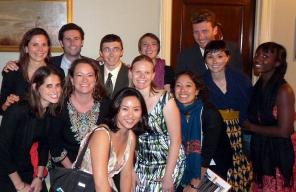
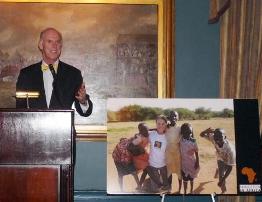
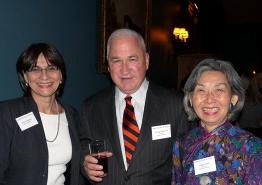
|
We’re Recruiting !
Know someone who’d be a great PiAf Fellow? As we recruit candidates for our 2010-2011 fellowship year, we need your help! Please tell your friends about PiAf and encourage them to apply.
We are pleased to announce that we are now accepting applications from graduating seniors in the Class of 2010 and young alumni from any college or university in the U.S. We feel this new policy will enable us to continue to place the highest caliber of young leaders in Africa as we grow.
Prospective candidates should visit our Applicants page for more information. |
|
Alumni Fundraising Campaign
Many thanks to all who donated to our alumni fundraising campaign. The money raised will fund scholarship opportunities for Fellows who need an extra boost during this difficult financial period; these scholarships subsidize the cost of flights and other larger expenses Fellows may encounter.
If you didn’t get a chance to donate and would still like to do so, it is not too late. Please Donate Now!
|
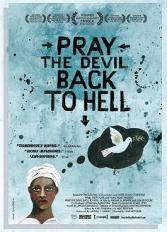
|
JOIN US |
|
October 20, 2009 7:00 pm
A free screening followed by a moderated discussion. Refreshments will be provided. |
|
Pray the Devil Back to Hell is the gripping account of a group of brave and visionary women who demanded peace for Liberia, a nation torn to shreds by a decades-old civil war. This film recounts the experiences and memories of the women who stood up to their country’s tyrannical leader and brutal warlords to bring peace to their tormented country. |

|
When I tell someone that I am spending my first year out of Princeton working for the Lutheran World Federation (LWF) in Burundi, I usually get the same reaction: shock, concern, and confusion. Burundi? Where is that again? Is it stable? Squeezed in between the DRC and Tanzania, Burundi remains anonymous to most of the world and not long ago that included me.
However, for the past six weeks I have been working in the capital city of Bujumbura and in Cankuzo and Ruyigi, two provinces near the Burundian-Tanzanian border. Although I live in Bujumbura, I travel to Ruyigi and Cankuzo to work with my colleagues and visit the projects (90% of LWF’s staff and projects are located in Ruyigi and Cankuzo). At the moment, I am helping launch LWF’s new Community Empowerment Project, which aims to empower the community to take charge of its own development.
Very quickly after my arrival, I became aware of some of the problems that plague Burundi: overpopulation, fragile peace, severe underdevelopment, a surge of returnees from neighboring nations, and overall widespread poverty. Perhaps the most striking aspect of the country for me so far has been the sheer simplicity of life. Before coming here, I could have never imagined a functioning society that has cars with steering wheels on both sides and lacks traffic lights and many other things I deemed necessary for any society—even a developing nation such as Burundi. For someone coming from the United States, the size and uniformity of Burundi was also striking. By the end of my second week, I had traversed the country and come back in only two car rides of four hours each and found that Burundians on the other side of the country eat the same foods, speak the same language, and have similar appearances.
Despite the cultural uniformity of the country, there is, nonetheless, a wide variance in the economic status of the country. Traveling from Bujumbura to Cankuzo, there is a noticeable decline in development: less cars, less houses, less shops, poorer roads, more dust. By the time you arrive in Cankuzo, only a few houses far apart from each other, unpaved roads, very limited running water, a lot of dust, and about 10 hours of sunlight await you. If you were to venture even further into the rural areas, you would notice an even steeper drop in development. The contrast between Bujumbura and the field is stark; yet, the beautiful landscape and the friendly people remain a constant.
Often, locals ask me, “Comment tu trouve le Burundi” (How do you like Burundi?). I answer, “J’aime bien, c’est un beau pays” (I like it, it’s a beautiful country). Each time I have said it, I have meant it, and despite the good intentions of my friends and family, living in Burundi is really no cause for concern. In fact, I am looking forward to being here for the rest of my fellowship year as I expect to continue to learn more about Burundi and to contribute to LWF’s projects. |
|
by Luwam Berhane, ‘09-’10 Fellow at Lutheran World Federation in Burundi |
|
Notes from the Field |
|
A literacy training workshop run by LWF |
|
Luwam (left) meeting with LWF colleagues |
|
Luwam, prior to her departure for Burundi |

|
“There are buffalo around, but, ah, if they charge it’s ok. There are many, many good trees to climb. Just find a tall one.” It was my first day out in the bush when I was given this piece of advice from one of the research assistants at the Mpala Research Center. I wasn’t sure how long I would last; tree climbing isn’t one of my strong suits.
Life at the Mpala Research Center (MRC), located just north of Mt. Kenya, is anything but ordinary. It is a haven for biological research with numerous projects being conducted year-round by universities from all over the world. It is an area rich in flora and fauna where you see elephants, zebra, and giraffe every day. They are often right outside your front door.
Mpala is home to the world’s only population of the endangered Grevy’s zebra. Protection from poachers along with research is giving the Grevy’s zebra a fighting chance at evading extinction. Another commonly poached animal, the elephant, is free to roam Mpala without the everyday threat of being shot for ivory. Much research conducted at MRC focuses on human-wildlife interactions and how they affect each other. I have been working with MRC’s director and the resident researcher on a project focusing on carnivore communities in human-dominated landscapes. With small populations of lions, cheetahs and leopards living on Mpala, any information that helps us understand how human populations affect the meat-eaters and how they react will help to maintain the delicate coexistence of man and beast.
Besides acting as the host to a large biological research community, Mpala maintains several community outreach programs. Through an education fund, Mpala is able to support its own school and offer the children of the MRC and ranch community an education. Additionally, an after-school program the Conservation Club teaches children about the surrounding environment and wildlife and the importance of conserving the natural habitat. I have helped to teach at some of the meetings and it is extremely inspiring to see how enthusiastic the kids are when experimenting with hands-on activities or attentively listening as aspects of evolution and physiology are explained.
The Mpala school and Conservation Club are relished by many children but it can be difficult to acquire the needed materials for each student due to a limited amount of funds. Brainstorming and acting on ways to bring in more funding for the children of Mpala has become a high priority for me over the next year.
With over 100 locals employed, Mpala is home to a very tight-knit community. It has provided me with the opportunity to interact daily with Kenyans who come from all different tribes including Turkana, Maasai and Kikuyu. From playing the Kenyan card game Cardi with a group from the village (which inevitably ends in all of us roaring with laughter) to jumping and shaking at a Turkana dance party to playing in several soccer matches against rival ranches, the time has been flying by. There’s still so much more to do. To say the least, I’m grateful the buffalo let me get through the first day. |
|
by Allison Williams, ‘09-’10 Fellow at Mpala Research Center in Kenya |
|
Notes from the Field |
|
One of the lab buildings at the Mpala Research Center |
|
Allison (in the dark blue shirt) working out in the bush to set up cameras that will capture photos of wildlife to help researchers learn about animal behavior |
|
Allison with one of the elephants that roams at Mpala (the elephant is in the center of the picture, just over Allison’s shoulder!) |
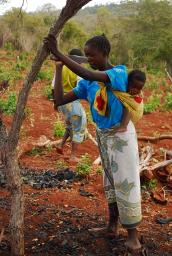
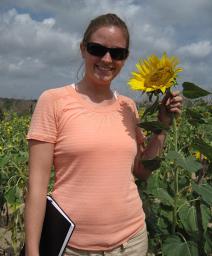
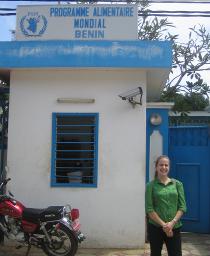
|
Adrienne in front of the WFP office in Benin |
